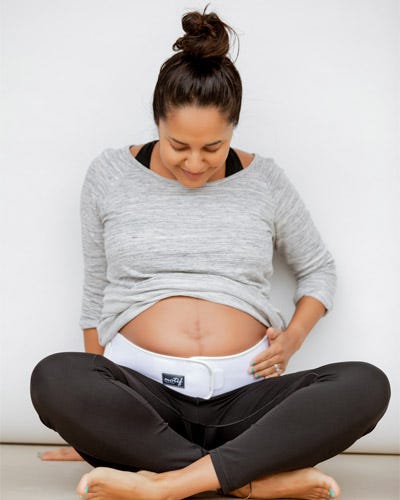The human body is so amazing and the transformation that happens when you're pregnant is simply incredible! From the outside, you probably get lots of compliments about your prenatal glow and who doesn't like to feel those sweet baby kicks? But when you're growing a baby, how can you keep up with the changes in body mechanics and alignment? How do you learn to adjust to your ever changing body? Let's look at the benefits of prenatal yoga as a way to help yourself have a stay comfortable in your pregnant body, have a healthy pregnancy, and reduce your pregnancy symptoms.
If you've already been to see your healthcare provider, then you've probably heard how important exercise is while you're pregnant. According to the American College of Obstetricians and Gynecologists, pregnant women should aim to get at least 150 minutes of moderate exercise every week.1 Having a regular exercise routine will help reduce swelling and back pain while also improving other discomforts such as constipation and insomnia. Studies have shown that regular exercise can also improve a person's mental wellbeing by reducing their symptoms of depression and anxiety and increasing their self-esteem.2 Movement during pregnancy is essential for your developing body and modified yoga or pilates is a perfect way to stay active. In fact, prenatal yoga may be one of the best ways to connect your mind and body so that you can enjoy your pregnancy.
Starting a daily prenatal yoga practice can help pregnant women adapt their movement habits to support their core and pelvic floor. This will help you maintain optimal posture and positioning during pregnancy and birth! The mindfulness of yoga is a way to connect your mind and body with your daily movement patterns and is an ideal way to keep being comfortable moving around as your baby and your body grow. Regular yoga practice helps expectant moms practice breathing techniques to optimize core function throughout the the pregnancy and prevent pregnancy issues like preterm labor and lower back pain.
So here's a rundown on what you need to know before you go to your first prenatal yoga class:


1. Anyone can go to prenatal yoga classes
As long as you haven't been put on bed rest, it doesn't matter if this is your first time doing yoga or you're a yogi who's had a regular yoga routine for years--attending a yoga program or doing yoga videos during pregnancy is beneficial. Pregnant women often use bolsters, yoga blocks, or blankets to help them achieve proper alignment during the yoga flow, which makes this a really wonderful time to start taking yoga classes. Plus, prenatal yoga classes are specifically designed for the pregnant body: not all yoga poses are safe to do during pregnancy due to the additional weight of the baby and the looseness of your joints and connective tissues, particularly in the third trimester. The good news is that your yoga teacher will know all of the ways to keep you safe during your yoga flow.
2. You can take yoga classes all throughout pregnancy
Prenatal yoga is safe to be practiced from the first trimester all the way through delivery. Depending on the length and intensity of your yoga class, it is safe to take yoga 3 to 5 times a week. And yoga is also a great way to ease back into exercise during the postpartum. Just like there are prenatal yoga classes designed specifically for expectant women, there are also postnatal yoga programs, designed to help your body recover after birth.
3. Regular yoga practice helps reduce pregnancy related aches and pains
Participating in regular yoga flow will lengthen and strengthen the muscles in your glutes and hamstrings and also help your core to function optimally. This will help you keep good alignment and functional movement patterns throughout your pregnancy, which will reduce the number of aches and pains you experience.
4. Prenatal yoga practice help baby be in an optimal birth position
Because yoga focuses on alignment and movement, this will help your baby get into the optimal birth position in the third trimester. The balance and space that is created by functional movement patterns, enables baby to navigate the space in the most ideal way.
While yoga is a wonderful form of exercise during pregnancy, it's important to find a yoga instructor who know what is safe and what is not when you're expecting. Hot yoga, poses that involve backbends or twists, or spending time on your back is not recommended during pregnancy. If you can't find a prenatal yoga class to attend, discuss your pregnancy with your yoga teacher to make sure you are doing the appropriate modifications during the flow.
Click here to watch Yoga & Strength Training accompanied by a Q&A with Motif’s compression director.








